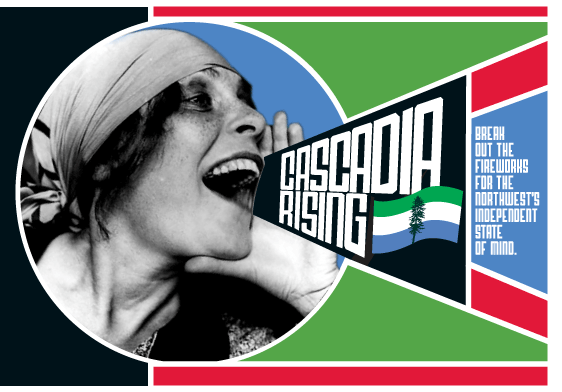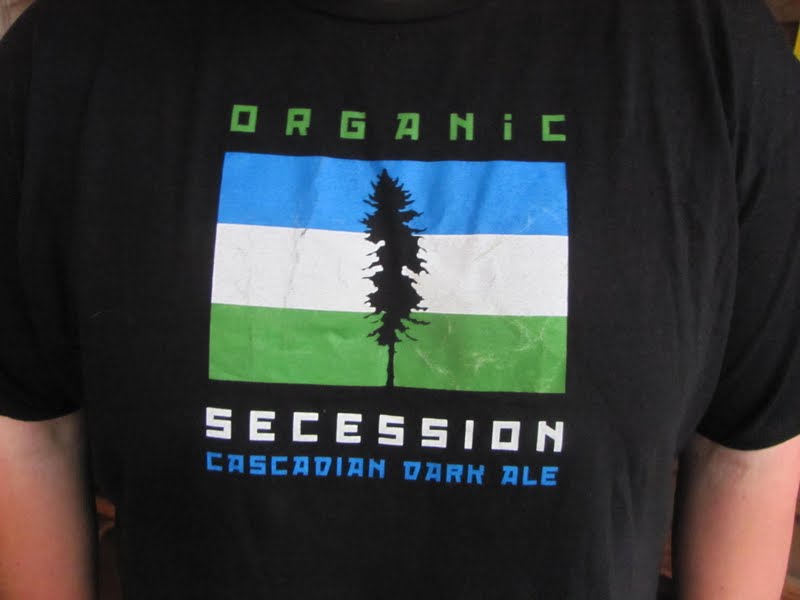The idea for an independent nation on the Pacific Coast of the North American continent dates back hundreds of years to Thomas Jefferson and even earlier. Collected below is a series of excerpts documenting early efforts for Pacific Northwest independence.
1813: A Letter from Thomas Jefferson
An 1813 letter from Thomas Jefferson to John Jacob Astor congratulated Astor on the establishment of Fort Astoria (the coastal fur trade post of Astor's Pacific Fur Company) and described Fort Astoria as
"the germ of a great, free, and independent empire on that side of our continent, and that liberty and self-government spreading from that as well as from this side, will insure their complete establishment over the whole."
He went on to dub this the “Republic of the Pacific”. In his mind, this nation was to be home to a “great, free and independent empire”, populated by American settlers, but separate from the United States politically and economically, and eventually becoming a great trading partner exploring its own democratic experiment.
1825: The Cascades are Given Name
Throughout the 1820’s, Scottish naturalist David Douglas, after whom the Doug Fir was named, spent much time exploring the Pacific Northwest. While he was searching for plants near the mouth of the Columbia gorge in 1825 he was struck by the areas ‘cascading waterfalls’. As he writes in his journals he talks in depth about the mountains by these ‘great cascades’ or later, just simply the Cascades, the first written reference to the mountain range that would later bear this name. It would be from this delineation that the term Cascadia would later be created.
1839: The Argument for an Independent Pacific Coast Republic
In the February edition of the Oregonian and Indian Advocate, a case was laid out by the articles author, known only as ‘W’, for the logical creation of a country along the Pacific Coast, stretching from California through the entirety of the Oregon Territory, then comprising Oregon, Washington, Idaho and British Columbia. At this time, the Oregon country was a neutrally aligned area in which the British, American, Russian governments all had a stake, with Spain still controlling large swaths of California.
In the article, the author argues that the general prevailing sentiment of the US populace was the country was large enough, noting that “The feeling is now very prevalent that we have territory enough. It is in every one's mouth, ‘We have territory enough, why do we want more?" and it would be hard indeed to persuade the people to relish a war for a tract of land most of them do not want, and many of them would be unwilling to have attached to the United States. With the merchants, and the people against it, shall we have war for Oregon? Will the Executive, will the Congress plunge the nation in carnage and blood against the people's will, for a tract of country the nation cares but little for?
He goes on to argue that “during this time, while the United States and England are with the greatest ceremony disputing and negotiating, thousands will be pressing into the territy. It will be settled, and Oregon and California will be united in a common cause and destiny. Then will come the realization of the event which Mr. Jefferson predicted, and "the whole extent of that coast will be covered with free and independent Americans, unconnected with us, but by the ties of blood and friendship.”
He even argued the important role that bioregionalism would play “Nature herself has marked out Western America for the home of an independent nation. The Rocky Mountains will be to Oregon, what the Alps have been to Italy, or the Pyrenees to Spain. The Nation which extends itself across them, must be broken in the centre by the weight of the extremities. When we merely glance at a map, it seems absurd to suppose that Oregon is to belong to a nation whose capital is on the Atlantic Seabord. What! Must the people of that land be six months journey from the seat of Government? Must they send their delegates four thousand miles to represent them in the legislature of a nation with whom they can have but few common interests or sympathies?”
1841: Charles Wilkes Expedition first maps what will later become the Cascadia Bioregion
Military Commander Charles Wilkes, leader of a 1841 expedition to map the Pacific Northwest was the first to fully documentwhat later became known as the Cascadia bioregion. His map, published in 1845 fully documents the interconnectedness of the then Oregon Territories. The illustration cuts off in the north due to Imperial Russian control, and in the south due to Imperial Spanish control.
1855-1861: The Movement in Oregon for the Establishment of a Pacific Coast Republic
On June 15th, 1846, the treaty with Great Britain was signed that secured to the United States the territory of Oregon lying south of the 49th parallel. It was assumed that the American government would then organize a government for the newly acquired territory. However, the bill providing this organization didn’t occur until August 14, 1848 due to pro-slavery leaders in Congress who opposed a clause in the Oregon Provisional Government declaring that neither slavery nor involuntary servitude, except as punishment for crime, would ever be permitted in the territory.
The citizens of Oregon, many who felt it was through their efforts that the territory had been acquired, were outraged at what they felt was then a refusal by the US government to grant them necessary assistance and protection. In addition, the inability for citizens to elect their own representatives, those instead being appointed by the Eastern federal government, led to a dramatic increase of dissatisfaction throughout the 1850’s, culminating in a growing movement to demand Independence.
This is summed up well in by an article in 1855 from a periodical the Standard (run by the Democratic Party) entitled “Our Future”, published in Portland: “In a new country there are no old associations, no stereo typed habits which filter in an accustomed routine our actions and our thoughts. Yes, it is indeed too true that we must look for new and energetic governments in recently settled countries. . . . Can- it be possible that within a few years the Pacific coast will ask, and can secure, an independent government? . . .
“If Nature ever marked out the division of countries, it has done so in North America. The vast chain of the Rocky Mountains present an unmistakable boundary, and we have reason to believe that these boundaries, laid down by an over ruling providence, ought to be more strictly regarded.... Should we secure anything to our advantage by coming into the Union which we could, not have by ourselves? Let us think before we act. The growing disparity of habits between us and the Atlantic states, and the pecuniary advantages or disadvantages of a separation from the states, are not the only questions which ought to be considered. Is it policy for us to join a government, the different sections of which are even now antipodal on a most exciting question, and which are cultivating a spirit of disunion by their altercations?
These sentiments continued to grow, spawning into the Klamath, Trinity and Jackson movements, largely dying with the beginning of the US civil war in 1861.
1890: Proposal to Draw Western State Borders along Bioregional Lines
These earlier arguments fit into a growing movement towards the creation of Western US States based on bioregional principles, primarily that of watersheds. In a series of maps published in 1890, soldier, explore and geologist John Wesley Powell laid out his proposal for the “essential units of government, either as states or as watershed commonwealths”.
Using the arid regions of the United States as a basis, he argued that only a small fraction of the American West was suitable for agriculture and that the bulk of arid regions should be reserved for conservation and low-intensity grazing, reframing the national Jeffersonian grid already in place. These calls however, were soon trumped over in favor of the continuing expansion of powerful timber, coal and railroad interests, which strongly affected late 19th and early 20th US development patterns.
1916: Documenting the Movement for Independence:
These earlier attempts towards independence in the Pacific Northwest continued to be well documented. In a 1916 article in the Oregon Historical Quarterly, author Dorothy Hull helps capture these earlier sentiments “To fully understand the political tendencies of the West it is necessary to understand the Western spirit, for political platforms are but a more or less clear reflection of the spirit which animates those who frame them.”
She continues “The West has always been the home of democracy. The Western movement in the United States from its first inception was a democratic movement. The fur traders who blazed the trail to the West, and the ranchers and farmers who followed in their wake forging the broader path for civilization were not aristocrats, but the common people – rugged, self-reliant and ambitious… seeking cheap lands, and a chance to work out their political and social ideas free from the aristocratic organization of the East. Hence in the West democracy, social and political, became the dominant force”.
“The early isolation of the West, and the completeness of its geographic separation from the political center of the nation fostered an intense feeling of local independence. It was not surprising then that in times of great public danger when vital sectional interests were believed to be at stake, this spirit of local independence should find expression in the doctrines of popular sovereignty, states-rights, nullification and even secession”.
1970: David McCloskey defines the ‘Cascadia Bioregion’
In 1970 the term "Cascadia" was adopted by David McCloskey, a Seattle University sociology professor, to describe the region. McCloskey describes Cascadia as "a land of falling waters." He notes the blending of the natural integrity and the sociocultural unity that gives Cascadia its definition.
McCloskey is the source of the proposed Cascadian bioregional boundaries that include the complete watershed of the Columbia River, including the territories of what is now Idaho, western Montana, and smaller parts of Wyoming, Utah, and northern Nevada. According to McCloskey, this "initial" Cascadia included parts of seven jurisdictions (Northern California, Oregon, Washington, Idaho, Western Montana, British Columbia, and Southeast Alaska), running from the northernmost reaches of Southeast Alaska in the north to Cape Mendocino, California in the south–and covering all the land and "falling waters" from the continental divide at the Rocky Mountains to the Pacific Ocean. McCloskey, founder of the Cascadia Institute and co‐chair of Seattle University’s New Ecological Studies Program, saw Cascadian identity as something which transcends political or geographic definitions; it is more a cultural, ideological identity.
David McCloskey returns to the original bioregional model of the Pacific Northwest which he dubs 'Cascadia'













